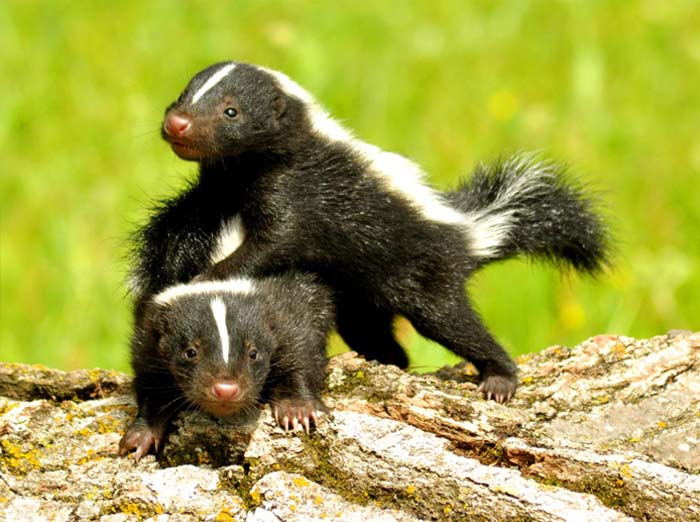
Skunks are placental, with a gestation period of about 66 days. Skunks mate in early spring and are polygynous (that is, successful males are uninhibited from mating with additional females.)īefore giving birth (usually in May), the female excavates a den to house her litter of four to seven kits. In captivity, they may live for up to 10 years. They are short-lived their lifespan in the wild can reach seven years, with most living only up to a year. Often, the same winter den is repeatedly used.Īlthough they have excellent senses of smell and hearing, they have poor vision, being unable to see objects more than about 3 m (10 ft) away, making them vulnerable to death by road traffic. Over winter, multiple females (as many as 12) huddle together males often den alone. However, they remain generally inactive and feed rarely, going through a dormant stage. Skunks are not true hibernators in the winter, but do den up for extended periods of time. Males and females occupy overlapping home ranges through the greater part of the year, typically 2 to 4 km 2 (0.77 to 1.54 sq mi) for females and up to 20 km 2 (7.7 sq mi) for males. During the day they shelter in burrows, which they can dig with their powerful front claws. Skunks are crepuscular and solitary animals when not breeding, though in the colder parts of their range, they may gather in communal dens for warmth. They have moderately elongated bodies with relatively short, well-muscled legs and long front claws for digging. Skunk species vary in size from about 15.6 to 37 in (40 to 94 cm) long and in weight from about 1.1 lb (0.50 kg) (spotted skunks) to 18 lb (8.2 kg) ( hog-nosed skunks). Skunk is also used to refer to certain strong-smelling strains of marijuana whose smell has been compared to that of a skunk's spray. In Southern United States dialect, the term polecat is sometimes used as a colloquial nickname for a skunk, even though polecats are only distantly related to skunks.Īs a verb, skunk is used to describe the act of overwhelmingly defeating an opponent in a game or competition. I believe the sin smelled by Saint Catherine de Sienne must have had the same vile odor. Your heart almost fails you when you approach the animal two have been killed in our court, and several days afterward there was such a dreadful odor throughout our house that we could not endure it. I would not have believed it if I had not smelled it myself. But it is so stinking and casts so foul an odor, that it is unworthy of being called the dog of Pluto. It is more white than black and, at the first glance, you would say, especially when it walks, that it ought to be called Jupiter's little dog. The tail is bushy and well furnished with hair, like the tail of a Fox it carries it curled back like that of a Squirrel. It has black fur, quite beautiful and shining and has upon its back two perfectly white stripes, which join near the neck and tail, making an oval that adds greatly to their grace. I mention it here, not on account of its excellence, but to make of it a symbol of sin. The other is a low animal, about the size of a little dog or cat. In 1634, a skunk was described in The Jesuit Relations:

Skunk has historic use as an insult, attested from 1841. The word skunk is dated from the 1630s, adapted from a southern New England Algonquian language (probably Abenaki) seganku, from Proto-Algonquian * šeka:kwa, from * šek- 'to urinate' + * -a:kw 'fox'. Spilogale pygmaea – pygmy spotted skunk.Spilogale putorius – eastern spotted skunk.Spilogale gracilis – western spotted skunk.Spilogale angustifrons – southern spotted skunk.Conepatus semistriatus – striped hog-nosed skunk.Conepatus leuconotus – American hog-nosed skunk.Conepatus humboldtii – Humboldt's hog-nosed skunk.

Conepatus chinga – Molina's hog-nosed skunk.A hooded skunk skeleton on display at the Museum of Osteology


 0 kommentar(er)
0 kommentar(er)
